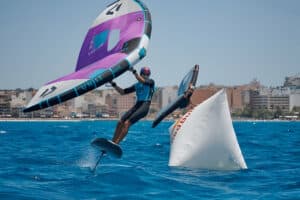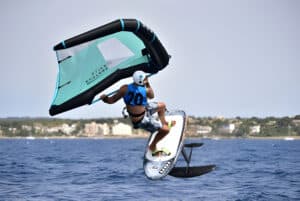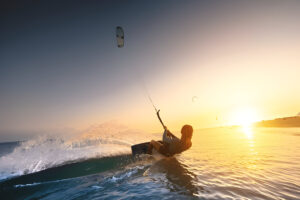Wing surfing and kitesurfing are both exhilarating water sports, but wing surfing is generally considered easier to learn and master than kitesurfing. This is primarily due to the simpler equipment setup and more intuitive control system of wing surfing.
While both sports harness wind power to propel riders across the water, wing surfing offers a more straightforward learning curve. The handheld wing used in wing surfing is easier to maneuver and control compared to the larger kite used in kitesurfing.
However, it’s important to note that ease of learning doesn’t necessarily equate to less excitement or challenge. Both sports offer unique thrills and opportunities for skill progression. In this article, we’ll explore the key differences between wing surfing and kitesurfing, and why wing surfing might be the better choice for beginners looking to get into wind-powered water sports.

Equipment and Setup
Wing surfing and kitesurfing both require specific gear, but there are notable differences in their equipment and setup processes. Wing surfing generally involves a simpler setup, which contributes to its reputation as being easier to learn than kitesurfing.
For wing surfing, the primary equipment includes:
- Inflatable wing: A handheld wing with an inflatable leading edge, typically ranging from 3 to 7 meters in size.
- Board: Either a foil board or a stand-up paddleboard (SUP) for beginners.
- Harness (optional): Some riders use a harness for additional support, but it’s not essential.
The setup process for wing surfing is relatively straightforward. Inflate the wing using a pump, attach the leash, and you’re ready to go. This simplicity allows for quick launches and easy transportation, making it an attractive option for active water sports enthusiasts.
In contrast, kitesurfing equipment is more complex:
- Kite: A large-sized kite, usually between 5 and 17 square meters, with an inflatable leading edge and struts.
- Control bar: Used to steer and control the kite.
- Lines: Multiple lines connecting the kite to the control bar.
- Board: Either a twin-tip board or a directional surfboard.
- Harness: Essential for connecting the rider to the kite.
The kitesurfing setup process is more time-consuming and requires more space on the beach. Kites need to be inflated, lines must be carefully laid out and connected, and the control bar system needs to be properly assembled. This complexity can be challenging for beginners and requires a higher level of skill to manage effectively.
Both sports can be practiced on various water surfaces, including lakes, flat water, and shallow water. However, wing surfing’s simpler setup makes it more adaptable to different environments and conditions, including light winds and gusty winds.
Controlling the Wing/Kite
In wingsurfing, the inflatable wing is held directly by the rider, offering more immediate and intuitive control. This direct connection allows for quicker adjustments and easier maneuverability, especially in gusty winds or light wind conditions.
Kitesurfing involves controlling a larger kite via a bar and lines system. This setup provides more power and lift but requires a higher level of skill to manage effectively. Kite control techniques such as steering, powering, and depowering are more complex and take longer to master. The kite’s size and power also make it more challenging to handle in varying wind conditions, particularly for beginners.
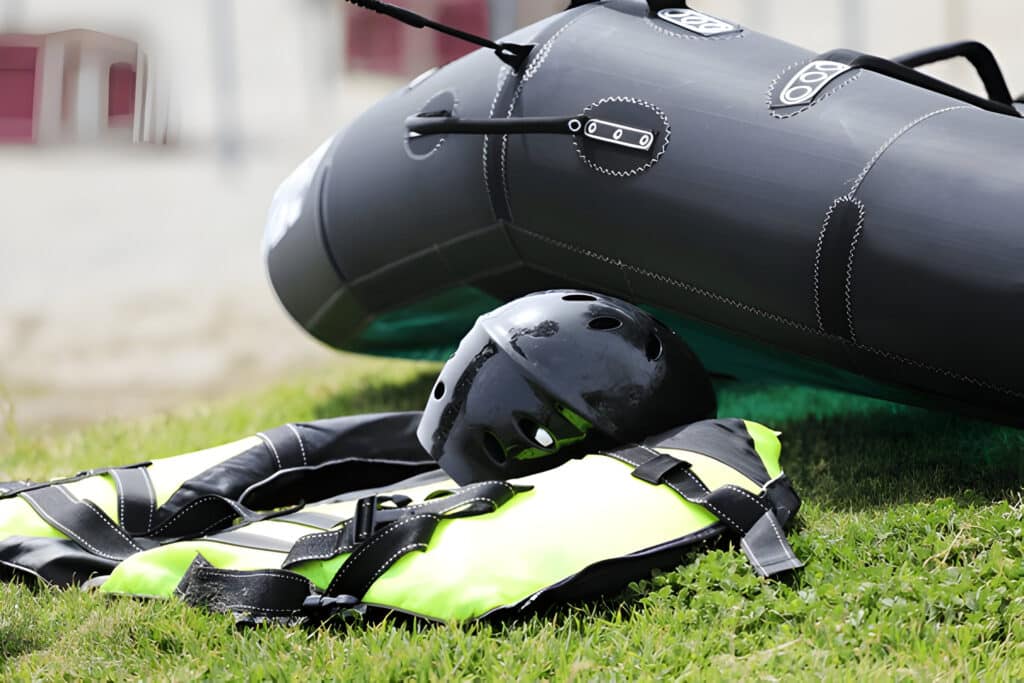
Learning Progression
In wing surfing, beginners can start with basic skills on land, practicing wing control and body positioning. This initial phase typically requires less time compared to kitesurfing, as the wing is more intuitive to handle. Most novices can progress to water starts within a few hours of instruction, often achieving their first rides on their first day.
Kitesurfing demands a more extensive learning process. Mastering kite control can take several days of focused practice. Beginners usually start with a trainer kite on land, learning to manipulate the kite’s power and direction. This phase can take anywhere from 2-4 days before progressing to water sessions.
Water starts in kitesurfing are more complex than in wing surfing. The coordination required between kite positioning, board control, and body posture is more challenging, often requiring multiple sessions to achieve consistent starts. Most kitesurfing schools estimate that it takes 6-12 hours of instruction spread over several days for a student to become independent.
Launching and Landing
In wing surfing, the inflatable wing can be easily handled by a single person, making it possible to launch and land without assistance. Wing surfers can launch by simply walking into shallow water, holding the wing, and allowing the wind to lift it. This process is less dependent on wind conditions and can be safely executed in a broader range of wind speeds. In contrast, kitesurfers must master specific techniques for launching their kites, such as the “power stroke” method, which requires precise timing and control.
Landing a wing is equally straightforward, as the rider can simply depower the wing and walk out of the water. Kitesurfing landings are more complex, often requiring a designated landing area and potentially an assistant to catch the kite. This complexity increases the risk of accidents during the landing phase, especially for less experienced riders or in challenging wind conditions.
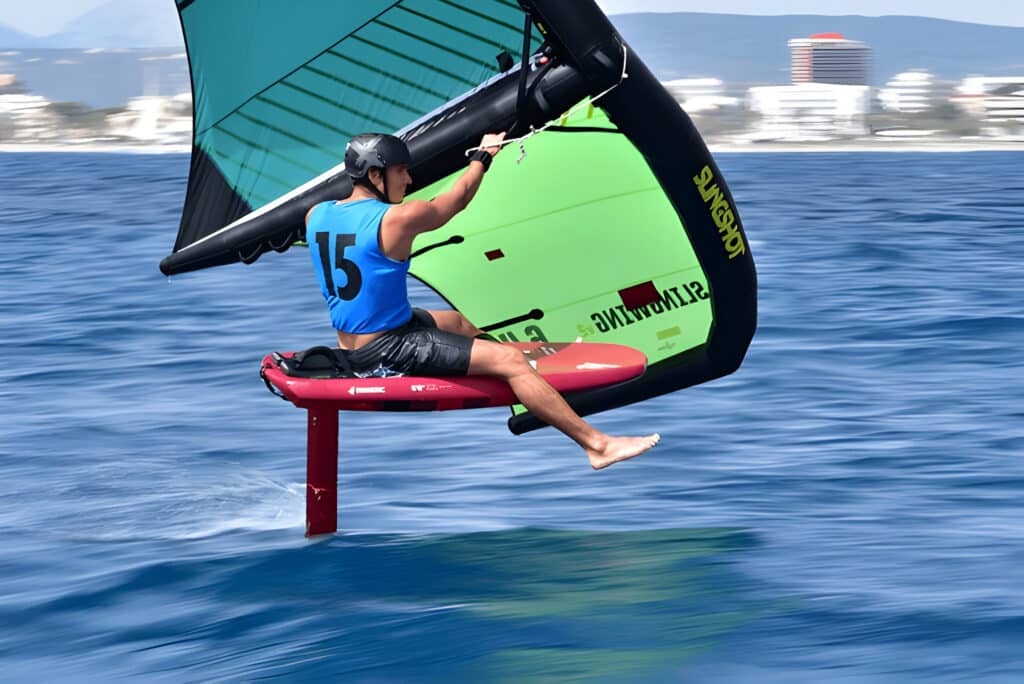
Wind Range and Water Conditions
For wing surfing, the comfortable wind range typically falls between 10-25 knots. This sport can be enjoyed in lighter winds, starting from as low as 8 knots, especially when combined with foiling (wing foiling). The inflatable wing’s design allows for efficient power generation even in these lighter conditions, making it an excellent option for lake sailors or those in areas with less consistent wind.
Kitesurfing, on the other hand, usually requires stronger winds to get started. The ideal wind range for kitesurfing is typically between 12-30 knots, with experienced riders able to handle even stronger winds. Large-sized kites can be used in winds as low as 10 knots, but this often requires more skill and technique to maintain consistent power.
In gusty winds, wing surfing tends to be more forgiving and easier to control. The direct connection between the rider and the wing allows for quicker response times to sudden changes in wind strength. Kitesurfing, while offering more power and speed potential, can be more challenging in gusty conditions due to the longer lines connecting the rider to the kite.
Wing surfing, especially when combined with foiling, can be performed in a variety of water conditions, including flat water and shallow water. This versatility makes it an excellent option for lakes and less ideal beach locations. Kitesurfing generally requires more open water and is better suited to coastal environments with consistent winds and waves.
Safety Considerations
Kitesurfing generally requires more safety precautions due to the larger size and power of kites compared to wings. The potential for accidents in kitesurfing is higher, especially for beginners. Large-sized kites can generate significant force, potentially dragging riders uncontrollably or lifting them into the air during gusty winds. This risk is less pronounced in wing surfing, where the inflatable wing is smaller and easier to control.
Kitesurfers typically venture further from shore, increasing the importance of self-rescue skills and proper safety gear. Wing surfers, on the other hand, often stay closer to the beach or in shallow water, reducing some risks associated with distance from shore.
Kitesurfing requires a broader range of wind speeds to be effective, which can expose riders to more challenging conditions. Wing surfing has a more comfortable range of wind speeds, making it potentially safer for beginners or in areas with variable wind patterns.
Kitesurfing setups involve more components, including lines and a control bar, which can become tangled or malfunction. Wing surfing equipment is simpler, with fewer parts that could potentially fail or cause injury.
Conclusion
In comparing wing surfing and kitesurfing, we’ve explored various aspects including equipment, control techniques, learning progression, launching and landing procedures, wind conditions, safety considerations. While both sports offer thrilling experiences on the water, wing surfing generally proves to be easier for beginners due to its simpler setup, more intuitive control, and gentler learning curve. However, kitesurfing offers greater versatility in terms of wind range and tricks.
Ultimately, the choice between wing surfing and kitesurfing depends on personal preferences, local conditions, and individual goals. As these water sports continue to evolve, enthusiasts can look forward to exciting innovations in equipment and techniques that may further blur the lines between the two disciplines.
